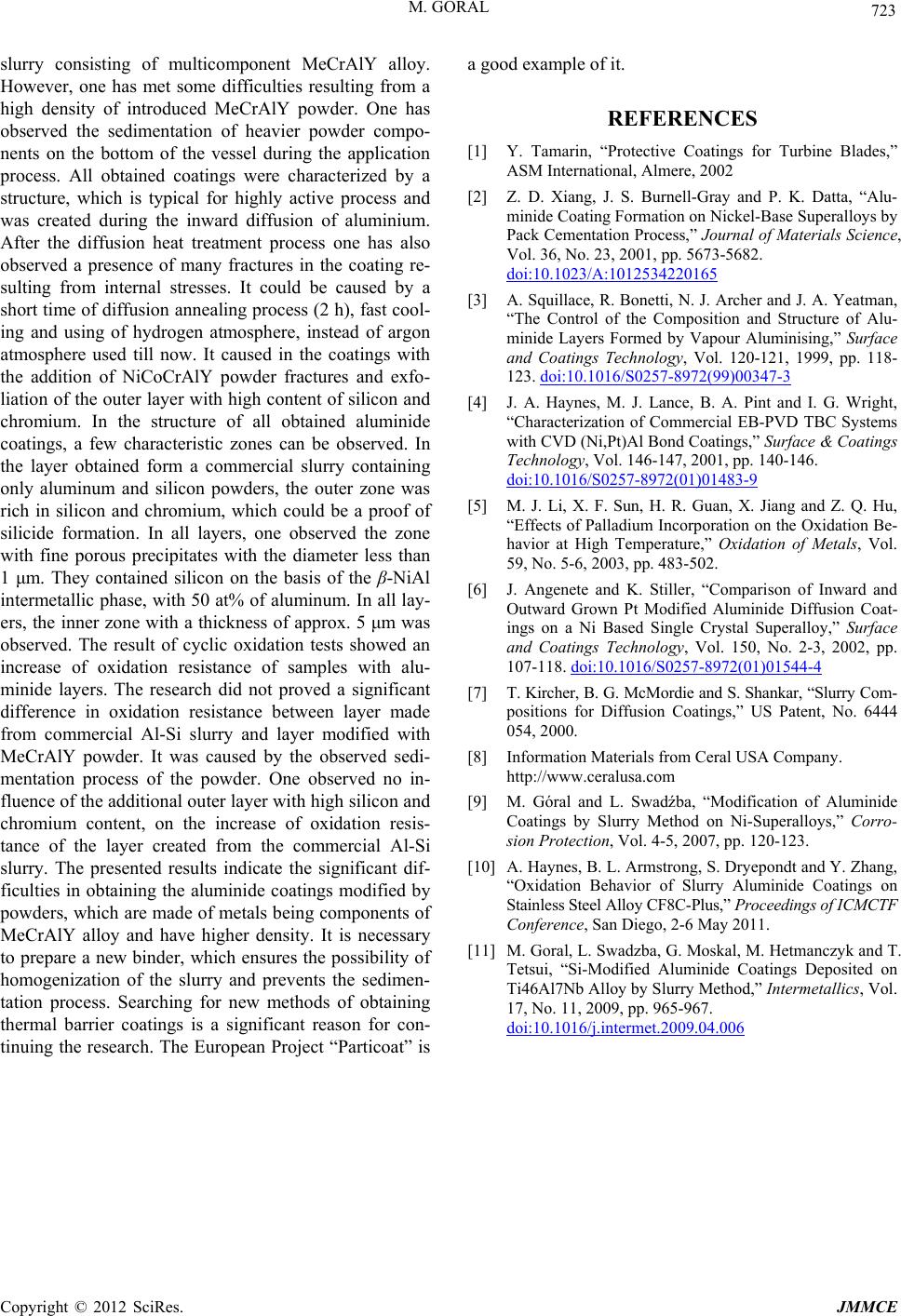
M. GORAL 723
slurry consisting of multicomponent MeCrAlY alloy.
However, one has met some difficulties resulting from a
high density of introduced MeCrAlY powder. One has
observed the sedimentation of heavier powder compo-
nents on the bottom of the vessel during the application
process. All obtained coatings were characterized by a
structure, which is typical for highly active process and
was created during the inward diffusion of aluminium.
After the diffusion heat treatment process one has also
observed a presence of many fractures in the coating re-
sulting from internal stresses. It could be caused by a
short time of diffusion annealing process (2 h), fast cool-
ing and using of hydrogen atmosphere, instead of argon
atmosphere used till now. It caused in the coatings with
the addition of NiCoCrAlY powder fractures and exfo-
liation of the outer layer with high content of silicon and
chromium. In the structure of all obtained aluminide
coatings, a few characteristic zones can be observed. In
the layer obtained form a commercial slurry containing
only aluminum and silicon powders, the outer zone was
rich in silicon and chromium, which could be a proof of
silicide formation. In all layers, one observed the zone
with fine porous precipitates with the diameter less than
1 μm. They contained silicon on the basis of the β-NiAl
intermetallic phase, with 50 at% of aluminum. In all lay-
ers, the inner zone with a thickness of approx. 5 μm was
observed. The result of cyclic oxidation tests showed an
increase of oxidation resistance of samples with alu-
minide layers. The research did not proved a significant
difference in oxidation resistance between layer made
from commercial Al-Si slurry and layer modified with
MeCrAlY powder. It was caused by the observed sedi-
mentation process of the powder. One observed no in-
fluence of the additional outer layer with high silicon and
chromium content, on the increase of oxidation resis-
tance of the layer created from the commercial Al-Si
slurry. The presented results indicate the significant dif-
ficulties in obtaining the aluminide coatings modified by
powders, which are made of metals being components of
MeCrAlY alloy and have higher density. It is necessary
to prepare a new binder, which ensures the possibility of
homogenization of the slurry and prevents the sedimen-
tation process. Searching for new methods of obtaining
thermal barrier coatings is a significant reason for con-
tinuing the research. The European Project “Particoat” is
a good example of it.
REFERENCES
[1] Y. Tamarin, “Protective Coatings for Turbine Blades,”
ASM International, Almere, 2002
[2] Z. D. Xiang, J. S. Burnell-Gray and P. K. Datta, “Alu-
minide Coating Formation on Nickel-Base Superalloys by
Pack Cementation Process,” Journal of Materials Science,
Vol. 36, No. 23, 2001, pp. 5673-5682.
doi:10.1023/A:1012534220165
[3] A. Squillace, R. Bonetti, N. J. Archer and J. A. Yeatman,
“The Control of the Composition and Structure of Alu-
minide Layers Formed by Vapour Aluminising,” Surface
and Coatings Technology, Vol. 120-121, 1999, pp. 118-
123. doi:10.1016/S0257-8972(99)00347-3
[4] J. A. Haynes, M. J. Lance, B. A. Pint and I. G. Wright,
“Characterization of Commercial EB-PVD TBC Systems
with CVD (Ni,Pt)Al Bond Coatings,” Surface & Coatings
Technology, Vol. 146-147, 2001, pp. 140-146.
doi:10.1016/S0257-8972(01)01483-9
[5] M. J. Li, X. F. Sun, H. R. Guan, X. Jiang and Z. Q. Hu,
“Effects of Palladium Incorporation on the Oxidation Be-
havior at High Temperature,” Oxidation of Metals, Vol.
59, No. 5-6, 2003, pp. 483-502.
[6] J. Angenete and K. Stiller, “Comparison of Inward and
Outward Grown Pt Modified Aluminide Diffusion Coat-
ings on a Ni Based Single Crystal Superalloy,” Surface
and Coatings Technology, Vol. 150, No. 2-3, 2002, pp.
107-118. doi:10.1016/S0257-8972(01)01544-4
[7] T. Kircher, B. G. McMordie and S. Shankar, “Slurry Com-
positions for Diffusion Coatings,” US Patent, No. 6444
054, 2000.
[8] Information Materials from Ceral USA Company.
http://www.ceralusa.com
[9] M. Góral and L. Swadźba, “Modification of Aluminide
Coatings by Slurry Method on Ni-Superalloys,” Corro-
sion Protection, Vol. 4-5, 2007, pp. 120-123.
[10] A. Haynes, B. L. Armstrong, S. Dryepondt and Y. Zhang,
“Oxidation Behavior of Slurry Aluminide Coatings on
Stainless Steel Alloy CF8C-Plus,” Proceedings of ICMCTF
Conference, San Diego, 2-6 May 2011.
[11] M. Goral, L. Swadzba, G. Moskal, M. Hetmanczyk and T.
Tetsui, “Si-Modified Aluminide Coatings Deposited on
Ti46Al7Nb Alloy by Slurry Method,” Intermetallics, Vol.
17, No. 11, 2009, pp. 965-967.
doi:10.1016/j.intermet.2009.04.006
Copyright © 2012 SciRes. JMMCE